
Quake II is a 1997 first-person shooter video game developed by id Software and published by Activision. It is the second installment of the Quake series, following Quake. The game's storyline is continued in its expansions, including one tying in Quake II and the first game, and Quake 4.

Quake is a first-person shooter game developed by id Software and published by GT Interactive. The first game in the Quake series, it was originally released for MS-DOS, Microsoft Windows, and Linux in 1996, followed by Mac OS and Sega Saturn in 1997 and Nintendo 64 in 1998. In the game, players must find their way through various maze-like, medieval environments while battling monsters using an array of weaponry. Quake takes inspiration from gothic fiction and the works of H. P. Lovecraft.

StarCraft is a real-time strategy video game developed and published by Blizzard Entertainment for Microsoft Windows. The first installment of the video game series of the same name, it was released in 1998. A Classic Mac OS version was released in 1999, and a Nintendo 64 port co-developed with Mass Media and published by Nintendo was released in 2000.
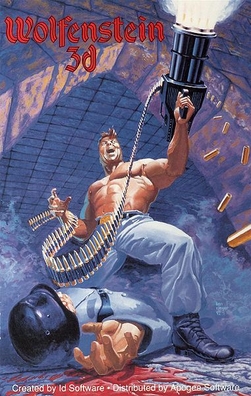
Wolfenstein 3D is a first-person shooter video game developed by id Software and published by Apogee Software and FormGen. Originally released on May 5, 1992, for DOS, it was inspired by the 1981 Muse Software video game Castle Wolfenstein, and is the third installment in the Wolfenstein series. In Wolfenstein 3D, the player assumes the role of Allied spy William "B.J." Blazkowicz during World War II as he escapes from the Nazi German prison Castle Wolfenstein and carries out a series of crucial missions against the Nazis. The player traverses each of the game's levels to find an elevator to the next level or kill a final boss, fighting Nazi soldiers, dogs, and other enemies with a knife and a variety of guns.
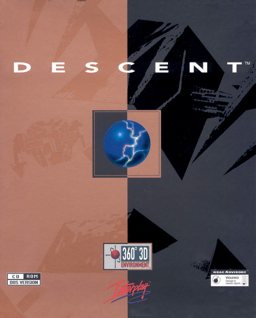
Descent is a first-person shooter (FPS) game developed by Parallax Software and released by Interplay Productions in 1995 for MS-DOS, and later for Macintosh, PlayStation, and RISC OS. It popularized a subgenre of FPS games employing six degrees of freedom and was the first FPS to feature entirely true-3D graphics. The player is cast as a mercenary hired to eliminate the threat of a mysterious extraterrestrial computer virus infecting off-world mining robots. In a series of mines throughout the Solar System, the protagonist pilots a spaceship and must locate and destroy the mine's power reactor and escape before being caught in the mine's self-destruction, defeating opposing robots along the way. Players can play online and compete in either deathmatches or cooperate to take on the robots.

Descent: FreeSpace – The Great War, known as Conflict: FreeSpace – The Great War in Europe, is a 1998 space combat simulation IBM PC compatible computer game developed by Volition, when it was split off from Parallax Software, and published by Interplay Productions. In 2001, it was ported to the Amiga platform as FreeSpace: The Great War by Hyperion Entertainment. The game places players in the role of a human pilot, who operates in several classes of starfighter and combats against opposing forces, either human or alien, in various space-faring environments, such as in orbit above a planet or within an asteroid belt. The story of the game's single player campaign focuses on a war in the 24th century between two factions, one human and the other alien, that is interrupted in its fourteenth year by the arrival of an enigmatic and militant alien race, whose genocidal advance forces the two sides into a ceasefire in order to work together to halt the threat.
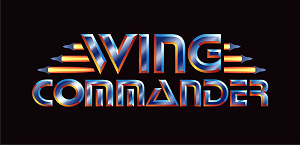
Wing Commander is a media franchise consisting of space combat simulation video games from Origin Systems, Inc., an animated television series, a feature film, a collectible card game, a series of novels, and action figures. The franchise originated in 1990 with the release of video game Wing Commander.
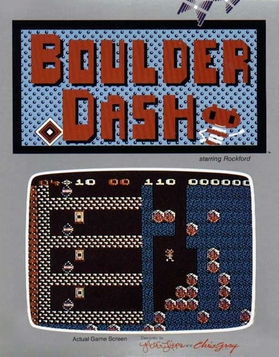
Boulder Dash is a 2D maze-puzzle video game released in 1984 by First Star Software for Atari 8-bit computers. It was created by Canadian developers Peter Liepa and Chris Gray. The player controls Rockford, who collects treasures while evading hazards.
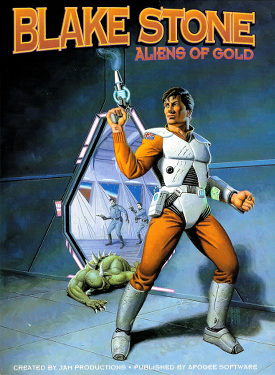
Blake Stone: Aliens of Gold is a first-person shooter for DOS created by JAM Productions and published by Apogee Software on December 5, 1993. The following year, a sequel called Blake Stone: Planet Strike was released, which continues where Aliens of Gold leaves off. Some copies of the game provided a Command Control Gravis Gamepad.

Trespasser is a 1998 action-adventure video game developed by DreamWorks Interactive and published by Electronic Arts for Microsoft Windows. The game serves as a sequel to the 1997 film The Lost World: Jurassic Park, taking place a year after the film's events. Players control Anne, the sole survivor of a plane crash that leaves her stranded on a remote island with genetically engineered dinosaurs. It features the voices of Minnie Driver as Anne and Richard Attenborough as John Hammond, reprising his role from the film series.

Descent II is a 1996 first-person shooter game developed by Parallax Software and first published for DOS by Interplay Productions. For the PlayStation, it is known as Descent Maximum. It is the second installment in the Descent video game series and the sequel to Descent. The base of the gameplay remaining the same, the player controls a spaceship from the pilot's perspective and must navigate extrasolar underground mines to locate and destroy their reactors and escape being caught in their self-destructions, while engaging and surviving infected robots, which will attempt to destroy the ship. Unlike other first-person shooters, its six-degrees-of-freedom scheme allows the player to move and rotate in any three-dimensional space and direction.

Raptor: Call of the Shadows is a vertically scrolling shooter developed by Cygnus Studios and published by Apogee Software. Its working title was "Mercenary 2029". It was released on April 1, 1994 for MS-DOS compatible systems. The first episode of the game, "Bravo Sector", was distributed as shareware. The other two episodes were sold commercially.

Terminal Velocity is a shooter video game originally developed by Terminal Reality and published by 3D Realms for DOS and Windows 95, and MacSoft for Mac OS. It is an arcade-style flight combat game, with simpler game controls and physics than flight simulators. It is known for its fast, high-energy action sequences, compared to flight simulators of the time.
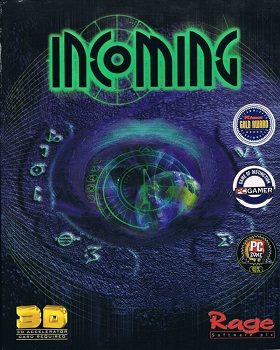
Incoming is a 3D shooter video game developed and published by Rage Software. The game was first released for Microsoft Windows in mid-1998, and was followed by a Dreamcast version, which was released in Japan on December 17, 1998, in Europe on October 14, 1999, and in North America on September 15, 1999. Set in the near-future of 2009, the game primarily revolves around controlling vehicles and turrets to fight alien invaders of Earth in one of the campaign modes, the arcade mode, and with or against another player. Some levels include brief real-time strategy segments.

Chaos Island: The Lost World is a real-time strategy video game for the PC, developed and published by DreamWorks Interactive, and based on the 1997 film The Lost World: Jurassic Park. Chaos Island was released in North America on October 30, 1997. In Chaos Island, the player controls characters displayed on a map, directing where they move with the mouse and giving them commands either with the mouse or from a menu.

Raiden IV is a 2007 vertical scrolling shooting video game developed by MOSS. It was first released in the arcades in Japan. A home conversion was produced for Xbox 360 in 2008. An updated arcade version was later released for Taito's NESiCAxLive digital distribution platform. Two more versions featuring new content were released: Raiden IV: OverKill for PlayStation 3 and Windows, and Raiden IV x MIKADO remix for Nintendo Switch, PlayStation 4, PlayStation 5, Windows, Xbox One, and Xbox Series X/S.
Raiden Fighters Jet is a 1998 vertically scrolling shooter arcade video game by Seibu Kaihatsu. It is a sequel to Raiden Fighters 2, released one year later. Raiden Fighters Jet retains the same game mechanics as its predecessors, while introducing new ones in a departure from the previous games.
StarCraft is a military science fiction media franchise created by Chris Metzen and James Phinney and owned by Blizzard Entertainment. The series, set in the beginning of the 26th century, centers on a galactic struggle for dominance among four species—the adaptable and mobile Terrans, the ever-evolving insectoid Zerg, the powerful and enigmatic Protoss, and the godlike Xel'Naga creator race—in a distant part of the Milky Way galaxy known as the Koprulu Sector. The series debuted with the video game StarCraft in 1998. It has grown to include a number of other games as well as eight novelizations, two Amazing Stories articles, a board game, and other licensed merchandise such as collectible statues and toys.

Raiden Fighters Aces is a 2008 video game for the Xbox 360, published by Japanese computer software company Success Corporation. It is a compilation of all three video games in the Raiden Fighters series by Seibu Kaihatsu: the first Raiden Fighters (1996), Raiden Fighters 2: Operation Hell Dive (1997), and Raiden Fighters Jet (1998).

Star Wars Jedi Knight: Mysteries of the Sith is an expansion pack for the 1997 first-person shooter Star Wars Jedi Knight: Dark Forces II, developed and published by LucasArts for Microsoft Windows in 1998. It was re-released on Steam in September 2009. The expansion includes a new single-player story mode and fifteen multiplayer maps. The single-player story, set in the fictional Star Wars expanded universe five years after the events of Dark Forces II, follows both returning protagonist Kyle Katarn, a Jedi Master and mercenary working for the New Republic, and Mara Jade, a character featured in numerous Star Wars expanded universe works, who is being trained by Katarn in the Jedi arts. After Katarn goes missing while investigating an ancient Sith temple, Jade continues her studies on her own while undertaking missions from the New Republic, eventually leaving to find Katarn.



















